HIPAA Training Plan Report: Protecting Patient Health Information
VerifiedAdded on 2020/05/28
|7
|1004
|144
Report
AI Summary
This report presents a comprehensive HIPAA training plan designed for Health Information Management (HIM) employees. The primary objective is to ensure that HIM staff understand and comply with HIPAA regulations, including the protection of patient health information. The plan outlines key content areas such as HIPAA Privacy Rules, civil and criminal penalties for violations, and the importance of maintaining patient confidentiality. It identifies various employee classes based on their roles and responsibilities within the healthcare setting, differentiating training content accordingly. The report details the training process, including class formats, time schedules, and required resources, such as trainers, financial support, and necessary equipment. A timetable for implementation over six months is also provided. The report also touches upon business requests and the process of responding to them, specifically referencing RFI (Request for Information) and its significance in the context of healthcare suppliers.

Running head: HIPAA TRAINING PLAN
HIPAA Training Plan
Name of the Student
Name of the University
Author Note
HIPAA Training Plan
Name of the Student
Name of the University
Author Note
Paraphrase This Document
Need a fresh take? Get an instant paraphrase of this document with our AI Paraphraser
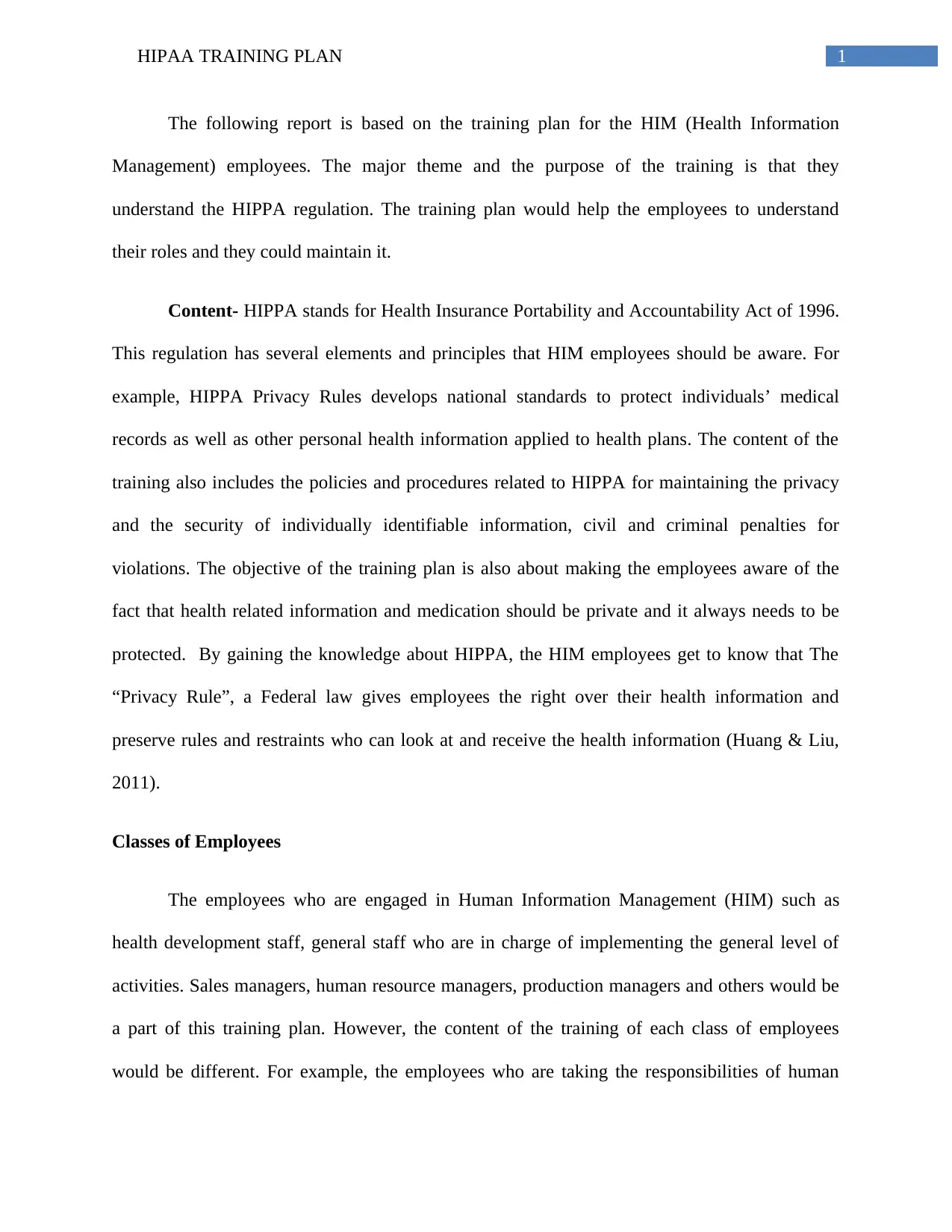
1HIPAA TRAINING PLAN
The following report is based on the training plan for the HIM (Health Information
Management) employees. The major theme and the purpose of the training is that they
understand the HIPPA regulation. The training plan would help the employees to understand
their roles and they could maintain it.
Content- HIPPA stands for Health Insurance Portability and Accountability Act of 1996.
This regulation has several elements and principles that HIM employees should be aware. For
example, HIPPA Privacy Rules develops national standards to protect individuals’ medical
records as well as other personal health information applied to health plans. The content of the
training also includes the policies and procedures related to HIPPA for maintaining the privacy
and the security of individually identifiable information, civil and criminal penalties for
violations. The objective of the training plan is also about making the employees aware of the
fact that health related information and medication should be private and it always needs to be
protected. By gaining the knowledge about HIPPA, the HIM employees get to know that The
“Privacy Rule”, a Federal law gives employees the right over their health information and
preserve rules and restraints who can look at and receive the health information (Huang & Liu,
2011).
Classes of Employees
The employees who are engaged in Human Information Management (HIM) such as
health development staff, general staff who are in charge of implementing the general level of
activities. Sales managers, human resource managers, production managers and others would be
a part of this training plan. However, the content of the training of each class of employees
would be different. For example, the employees who are taking the responsibilities of human
The following report is based on the training plan for the HIM (Health Information
Management) employees. The major theme and the purpose of the training is that they
understand the HIPPA regulation. The training plan would help the employees to understand
their roles and they could maintain it.
Content- HIPPA stands for Health Insurance Portability and Accountability Act of 1996.
This regulation has several elements and principles that HIM employees should be aware. For
example, HIPPA Privacy Rules develops national standards to protect individuals’ medical
records as well as other personal health information applied to health plans. The content of the
training also includes the policies and procedures related to HIPPA for maintaining the privacy
and the security of individually identifiable information, civil and criminal penalties for
violations. The objective of the training plan is also about making the employees aware of the
fact that health related information and medication should be private and it always needs to be
protected. By gaining the knowledge about HIPPA, the HIM employees get to know that The
“Privacy Rule”, a Federal law gives employees the right over their health information and
preserve rules and restraints who can look at and receive the health information (Huang & Liu,
2011).
Classes of Employees
The employees who are engaged in Human Information Management (HIM) such as
health development staff, general staff who are in charge of implementing the general level of
activities. Sales managers, human resource managers, production managers and others would be
a part of this training plan. However, the content of the training of each class of employees
would be different. For example, the employees who are taking the responsibilities of human
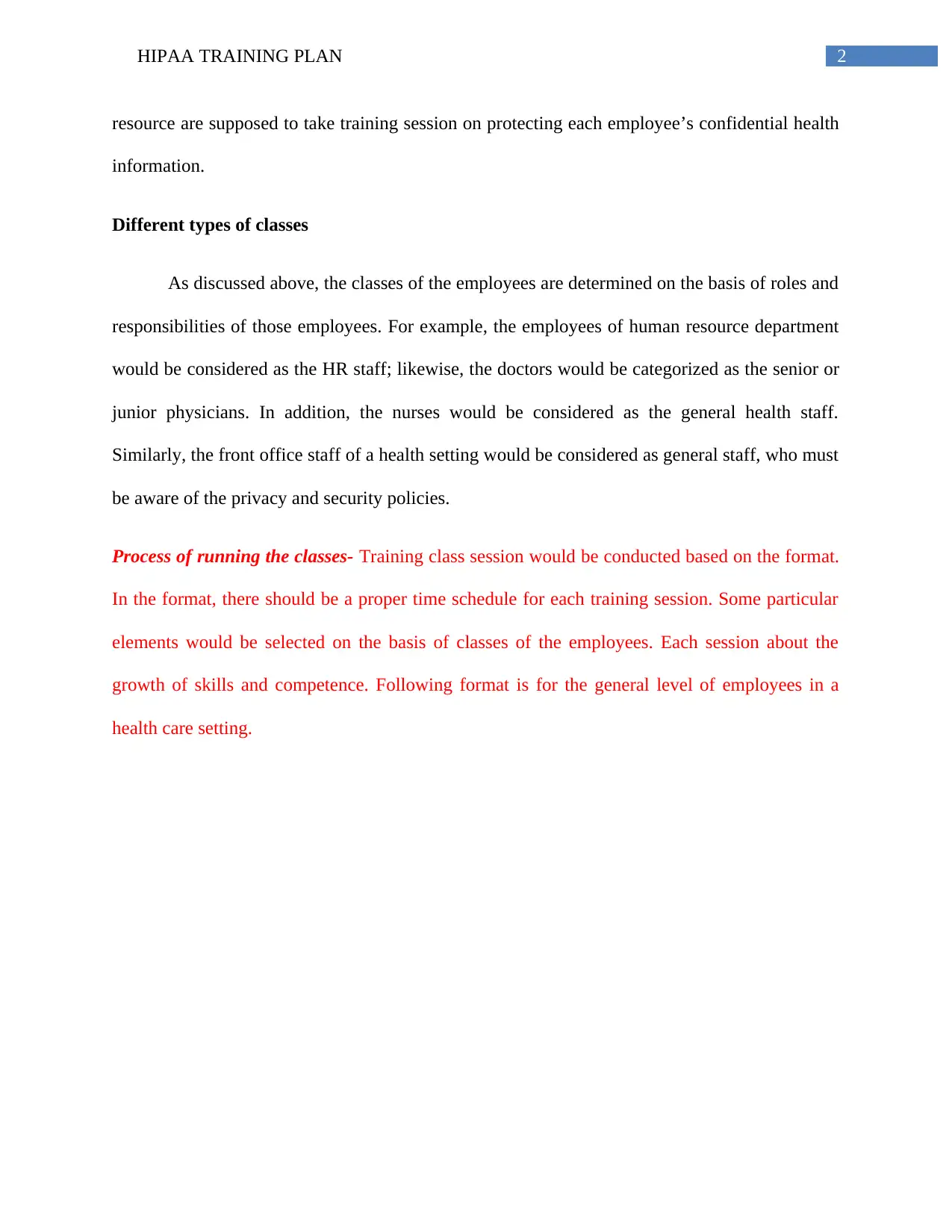
2HIPAA TRAINING PLAN
resource are supposed to take training session on protecting each employee’s confidential health
information.
Different types of classes
As discussed above, the classes of the employees are determined on the basis of roles and
responsibilities of those employees. For example, the employees of human resource department
would be considered as the HR staff; likewise, the doctors would be categorized as the senior or
junior physicians. In addition, the nurses would be considered as the general health staff.
Similarly, the front office staff of a health setting would be considered as general staff, who must
be aware of the privacy and security policies.
Process of running the classes- Training class session would be conducted based on the format.
In the format, there should be a proper time schedule for each training session. Some particular
elements would be selected on the basis of classes of the employees. Each session about the
growth of skills and competence. Following format is for the general level of employees in a
health care setting.
resource are supposed to take training session on protecting each employee’s confidential health
information.
Different types of classes
As discussed above, the classes of the employees are determined on the basis of roles and
responsibilities of those employees. For example, the employees of human resource department
would be considered as the HR staff; likewise, the doctors would be categorized as the senior or
junior physicians. In addition, the nurses would be considered as the general health staff.
Similarly, the front office staff of a health setting would be considered as general staff, who must
be aware of the privacy and security policies.
Process of running the classes- Training class session would be conducted based on the format.
In the format, there should be a proper time schedule for each training session. Some particular
elements would be selected on the basis of classes of the employees. Each session about the
growth of skills and competence. Following format is for the general level of employees in a
health care setting.
⊘ This is a preview!⊘
Do you want full access?
Subscribe today to unlock all pages.

Trusted by 1+ million students worldwide
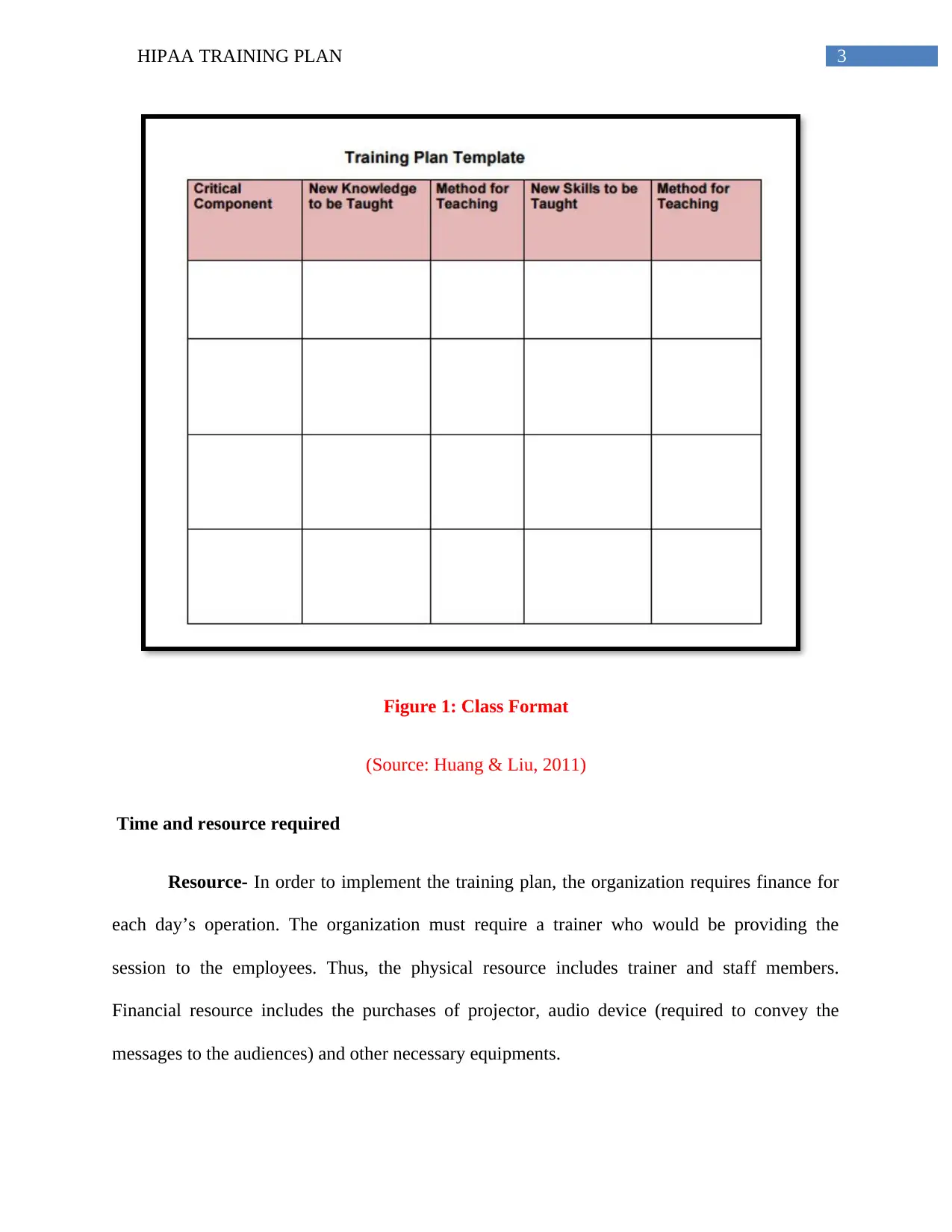
3HIPAA TRAINING PLAN
Figure 1: Class Format
(Source: Huang & Liu, 2011)
Time and resource required
Resource- In order to implement the training plan, the organization requires finance for
each day’s operation. The organization must require a trainer who would be providing the
session to the employees. Thus, the physical resource includes trainer and staff members.
Financial resource includes the purchases of projector, audio device (required to convey the
messages to the audiences) and other necessary equipments.
Figure 1: Class Format
(Source: Huang & Liu, 2011)
Time and resource required
Resource- In order to implement the training plan, the organization requires finance for
each day’s operation. The organization must require a trainer who would be providing the
session to the employees. Thus, the physical resource includes trainer and staff members.
Financial resource includes the purchases of projector, audio device (required to convey the
messages to the audiences) and other necessary equipments.
Paraphrase This Document
Need a fresh take? Get an instant paraphrase of this document with our AI Paraphraser
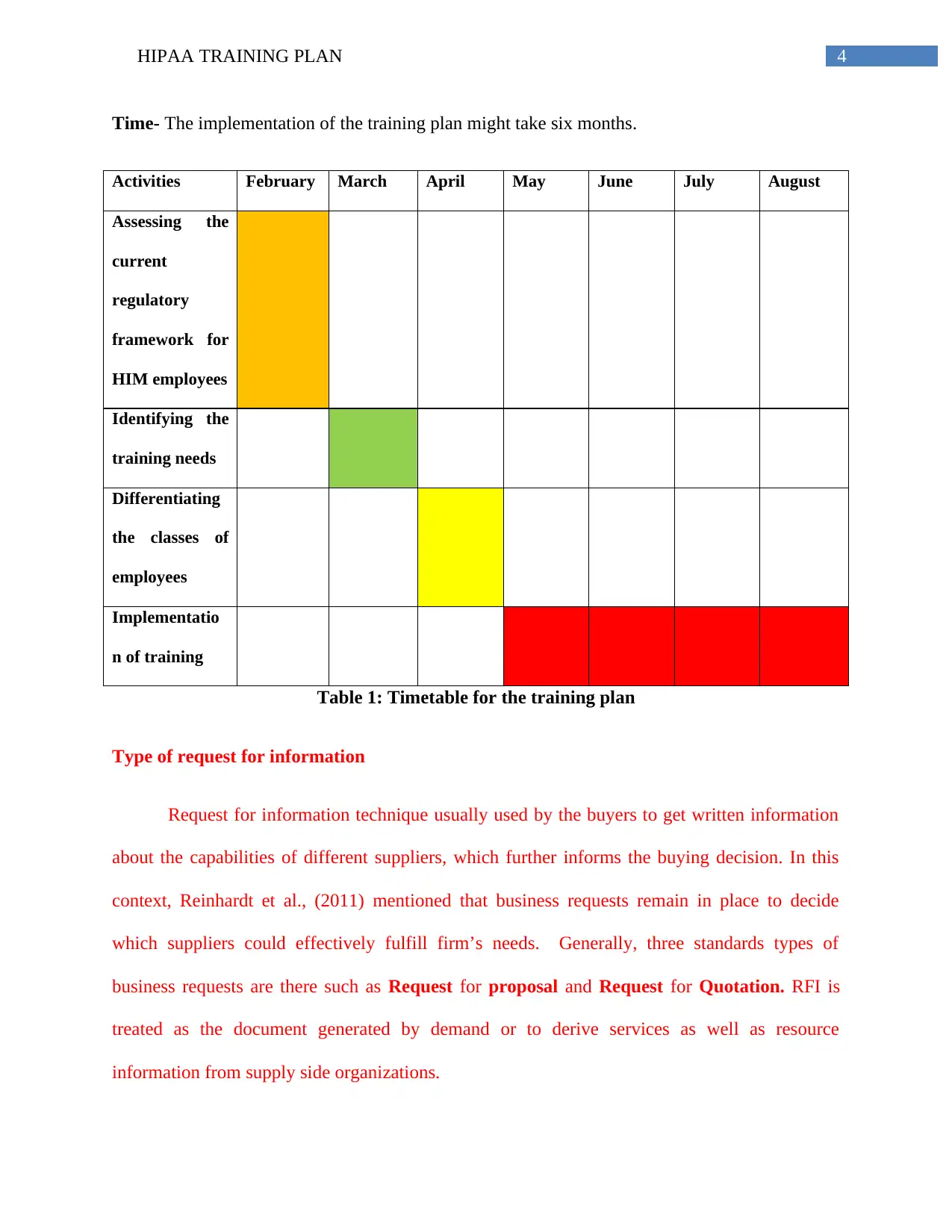
4HIPAA TRAINING PLAN
Time- The implementation of the training plan might take six months.
Activities February March April May June July August
Assessing the
current
regulatory
framework for
HIM employees
Identifying the
training needs
Differentiating
the classes of
employees
Implementatio
n of training
Table 1: Timetable for the training plan
Type of request for information
Request for information technique usually used by the buyers to get written information
about the capabilities of different suppliers, which further informs the buying decision. In this
context, Reinhardt et al., (2011) mentioned that business requests remain in place to decide
which suppliers could effectively fulfill firm’s needs. Generally, three standards types of
business requests are there such as Request for proposal and Request for Quotation. RFI is
treated as the document generated by demand or to derive services as well as resource
information from supply side organizations.
Time- The implementation of the training plan might take six months.
Activities February March April May June July August
Assessing the
current
regulatory
framework for
HIM employees
Identifying the
training needs
Differentiating
the classes of
employees
Implementatio
n of training
Table 1: Timetable for the training plan
Type of request for information
Request for information technique usually used by the buyers to get written information
about the capabilities of different suppliers, which further informs the buying decision. In this
context, Reinhardt et al., (2011) mentioned that business requests remain in place to decide
which suppliers could effectively fulfill firm’s needs. Generally, three standards types of
business requests are there such as Request for proposal and Request for Quotation. RFI is
treated as the document generated by demand or to derive services as well as resource
information from supply side organizations.
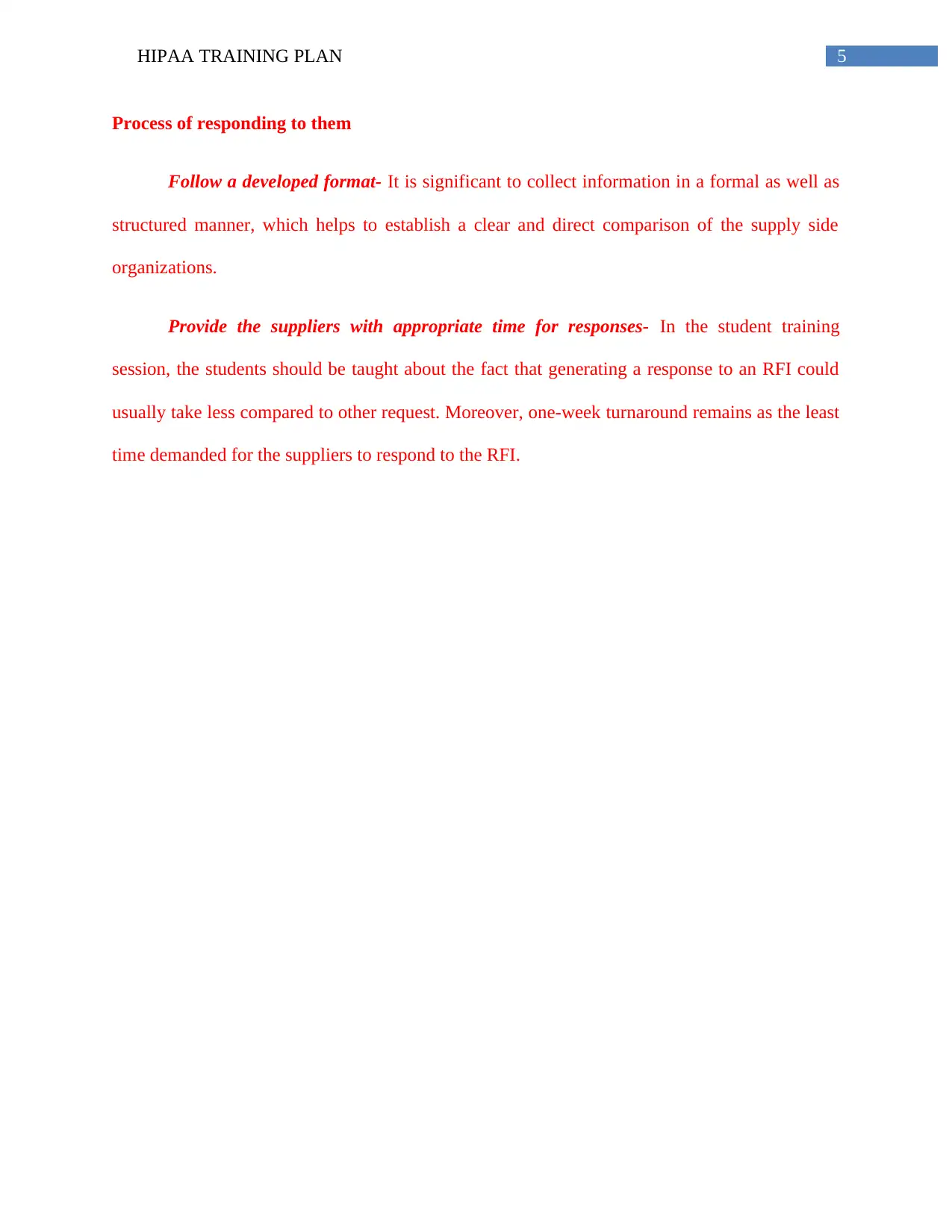
5HIPAA TRAINING PLAN
Process of responding to them
Follow a developed format- It is significant to collect information in a formal as well as
structured manner, which helps to establish a clear and direct comparison of the supply side
organizations.
Provide the suppliers with appropriate time for responses- In the student training
session, the students should be taught about the fact that generating a response to an RFI could
usually take less compared to other request. Moreover, one-week turnaround remains as the least
time demanded for the suppliers to respond to the RFI.
Process of responding to them
Follow a developed format- It is significant to collect information in a formal as well as
structured manner, which helps to establish a clear and direct comparison of the supply side
organizations.
Provide the suppliers with appropriate time for responses- In the student training
session, the students should be taught about the fact that generating a response to an RFI could
usually take less compared to other request. Moreover, one-week turnaround remains as the least
time demanded for the suppliers to respond to the RFI.
⊘ This is a preview!⊘
Do you want full access?
Subscribe today to unlock all pages.

Trusted by 1+ million students worldwide
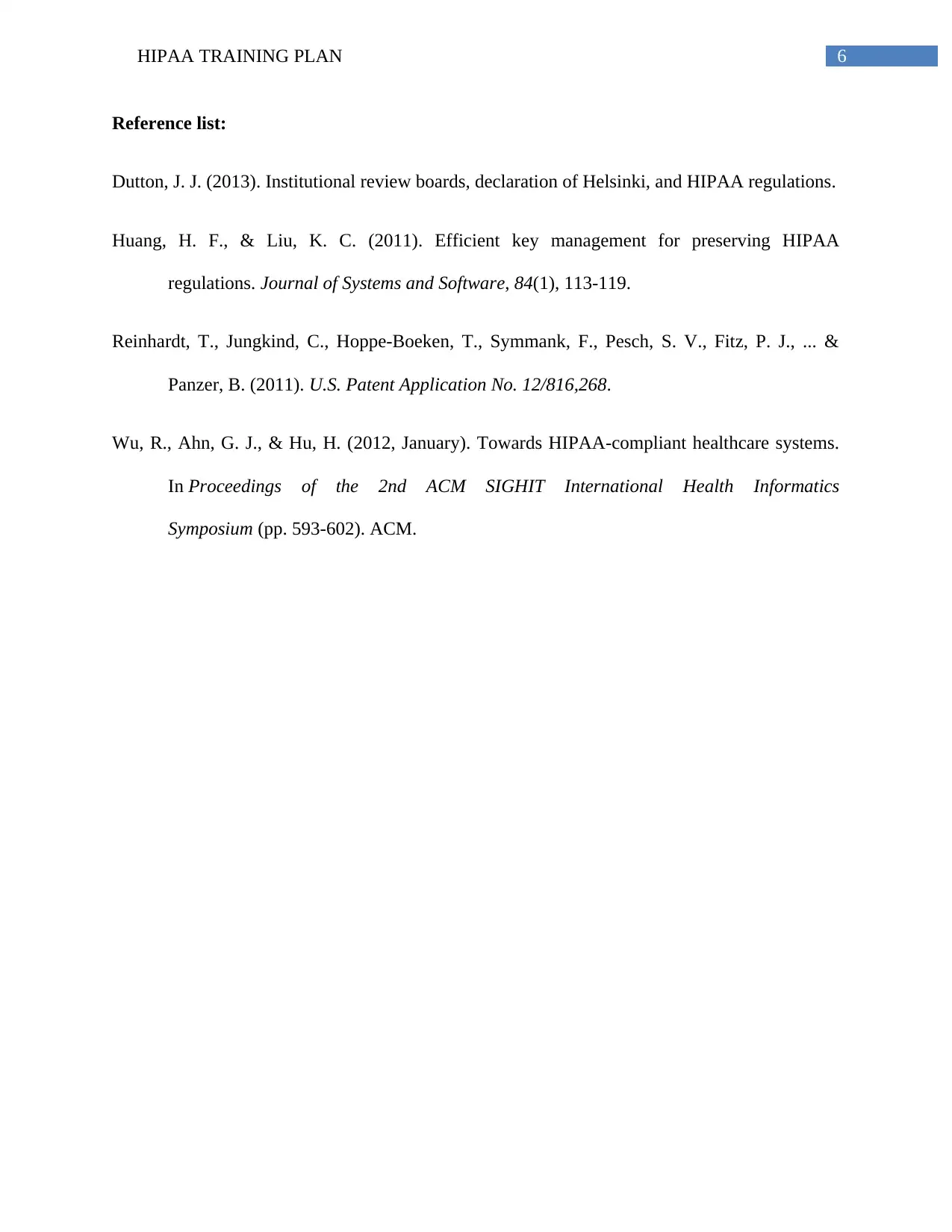
6HIPAA TRAINING PLAN
Reference list:
Dutton, J. J. (2013). Institutional review boards, declaration of Helsinki, and HIPAA regulations.
Huang, H. F., & Liu, K. C. (2011). Efficient key management for preserving HIPAA
regulations. Journal of Systems and Software, 84(1), 113-119.
Reinhardt, T., Jungkind, C., Hoppe-Boeken, T., Symmank, F., Pesch, S. V., Fitz, P. J., ... &
Panzer, B. (2011). U.S. Patent Application No. 12/816,268.
Wu, R., Ahn, G. J., & Hu, H. (2012, January). Towards HIPAA-compliant healthcare systems.
In Proceedings of the 2nd ACM SIGHIT International Health Informatics
Symposium (pp. 593-602). ACM.
Reference list:
Dutton, J. J. (2013). Institutional review boards, declaration of Helsinki, and HIPAA regulations.
Huang, H. F., & Liu, K. C. (2011). Efficient key management for preserving HIPAA
regulations. Journal of Systems and Software, 84(1), 113-119.
Reinhardt, T., Jungkind, C., Hoppe-Boeken, T., Symmank, F., Pesch, S. V., Fitz, P. J., ... &
Panzer, B. (2011). U.S. Patent Application No. 12/816,268.
Wu, R., Ahn, G. J., & Hu, H. (2012, January). Towards HIPAA-compliant healthcare systems.
In Proceedings of the 2nd ACM SIGHIT International Health Informatics
Symposium (pp. 593-602). ACM.
1 out of 7
Related Documents
Your All-in-One AI-Powered Toolkit for Academic Success.
+13062052269
info@desklib.com
Available 24*7 on WhatsApp / Email
![[object Object]](/_next/static/media/star-bottom.7253800d.svg)
Unlock your academic potential
Copyright © 2020–2025 A2Z Services. All Rights Reserved. Developed and managed by ZUCOL.




